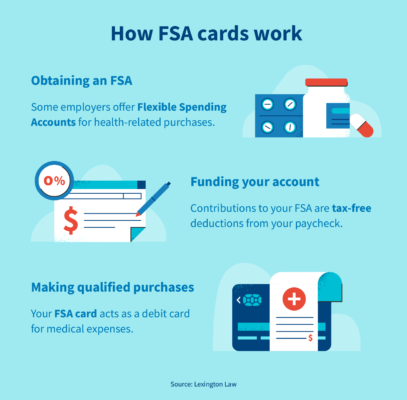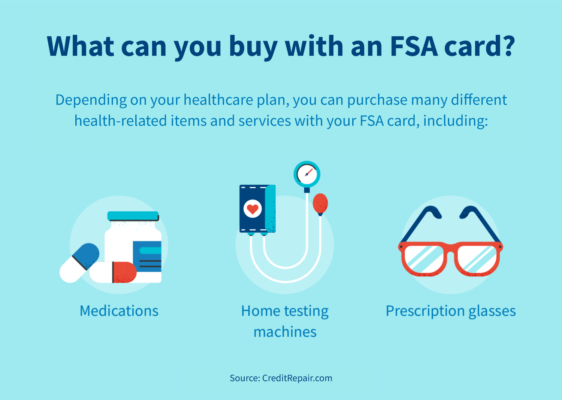
Disclosure regarding our editorial content standards.
A Flexible Spending Account (FSA) card can be used to pay for health-related expenses, like doctor’s visits or medications. Some employers offer healthcare plans with Flexible Spending Accounts, and contributions to these accounts are tax-free. That means you could potentially save money by using an FSA card to pay for certain medical expenses.
If your healthcare plan offers a Flexible Spending Account, it’s worth looking into whether it could help you save some money throughout the year.
Read on and we’ll show you what you need to know about how FSA cards work, the advantages and disadvantages of FSA cards and how FSA cards affect your credit.
How FSA cards work
Some employers provide healthcare plans that include a Flexible Spending Account (FSA), which is a special tax-advantaged account you can use to pay for medical expenses. You can fund this account with deductions from your paycheck, and some employers match your contributions as well.
The best part: All of the money that is contributed to your FSA is tax-free.

Your Flexible Spending Account will generally include an FSA card, which is used to make payments with the funds in your account. An FSA card is similar to a debit card—after you swipe the card, it pulls funds directly from your account to complete the transaction.
Remember these points:
- FSA cards can only be used to pay for qualifying medical expenses, so check your healthcare plan to see exactly what you can use the funds for.
- There is a limit on FSA contributions, which is currently set at $2,750 each year as of 2020—and certain plans may cap contributions at a lower amount.
- Money in an FSA is typically only valid for a specific time period, for example, a calendar year. Double-check your plan information to avoid losing any of your contributions.
Before opening a Flexible Spending Account, make sure you understand the advantages and disadvantages.
Advantages and disadvantages of FSA cards
While a Flexible Spending Account can potentially save you money over the course of the year, it’s best to be aware of both the advantages and the disadvantages before you start swiping an FSA card.
Advantages
- Contributions to an FSA are tax-free, which could lower your taxable income.
- Some employers will match your contributions, giving you more money to spend on medical expenses.
- Some plans have a broad range of qualifying purchases, like sunscreen, pregnancy tests or prescription eyeglasses.
Disadvantages
- These plans are generally “use it or lose it,” so unspent funds are lost.
- With a limit of $2,750 each year, you may still need additional money to pay for healthcare costs.
- If you change jobs mid-year, you may lose access to your FSA funds.
With all of this in mind, you can make the best decision for your situation. An FSA card can save you money on medical expenses, but make sure you have a good idea of your total costs—and especially make sure you have a plan to use the money so you don’t lose it.
Frequently asked questions
If you’re considering getting an FSA or already have one, you may have a few questions. Here are some of the most common questions about FSA cards.
How do I get an FSA card?
After signing up for a Flexible Spending Account (FSA) through your employer’s healthcare plan, you’ll usually receive your FSA card in the mail. You may need to activate your card when you receive it, and then you can begin using it to make eligible purchases for medical expenses.
How do I get cash from my card?
Although an FSA card is like a debit card in some ways, you can’t use it to withdraw cash. Instead, you’ll use your card directly at locations that accept FSA cards—typically medical establishments like pharmacies, doctor’s offices or hospitals. In certain circumstances, you can pay out of pocket and then get reimbursed later, but make sure that you always save receipts for health-related purchases.
What can I buy with an FSA card?
An FSA card can be used to buy a wide variety of health-related items, but the eligibility for items depends on your specific plan. Make sure to read your plan carefully or call your provider for more details. Often, an FSA card can be used for doctor’s visits, medications, home testing machines and prescription glasses, among other things.

What’s the difference between an FSA and HSA card?
Both Flexible Spending Accounts (FSA) and Health Savings Accounts (HSA) are tax-advantaged accounts used to save money for medical expenses. Also, both of these plans will provide a card that can be used to make qualified purchases. The main difference is that an HSA is usually part of a high-deductible health plan, and funds from an HSA roll over to the next year, while funds from an FSA are usually lost if they aren’t used.
Can I use my card online?
In general, businesses that accept FSA cards will allow you to use your card online. Typically, you’ll enter your card number just as you would when making a debit or credit card payment. In any case, you still need to make sure you’re only using the FSA card for qualified purchases, and it’s best to save your receipts as well.
Will my FSA card usage affect my credit score?
Because FSA cards are essentially debit cards, they don’t show up on your credit report and they don’t affect your credit score. The reason for this is simple: An FSA card is used to spend money that you’ve already deposited into an account. On the other hand, your credit report details any account where a financial institution lends you money with the expectation that you’ll pay it back later.
That said, you may have concerns about your credit score unrelated to your FSA card. A low credit score can make it difficult to get a mortgage or good rates for a car loan. We’re here for you if you need help fixing your credit so that your score aligns with your goals.






